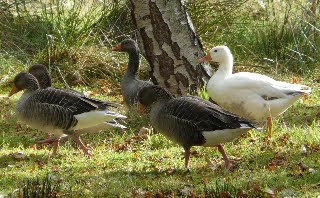A fine morning on Friday saw heaps of birds moving on way to work - 100's Pinks over Longniddry as usual, then a single species flock of 10 Barnacles, and another single with Pinks. While watching Barnies saw throo bins high in sky behind a large flock of plovers, 280 SW; immediately afterwards 70 Lapwings high NE, all from home. Passerines on the move again, with thrushes, finches and alba wag SW along coast; then 400+ Golden Plover over Dolphingstone, feeding there in ploughed and cereal recently; finally 40 Fieldfares NE over Newton village.
Another fine morning Saturday encouraged geese out early with 1000+ over at 08:15hrs; min 3 Barnacles in 1800+ by 09:55hrs. Shame the white Snow Goose is not around any more as still need this species for the garden list! Just after midday 1800+ Pinks located in the same fields at Buxley btwn the B6371 and B6355 just S of Tranent (2 collars, one was IJY), containing at least 13 Barnacles and 4 juv Whitefronts, just as the weather closed in and heavy rain commenced (perhaps same as recent Fenton Tower birds). The latter would have been a garden tick, but it's going to be a challenge to get them from home! Photos here, group including obvious dark bird under 2nd telegraph from right in first and 3 darker birds on left in second (one showing a hint of a white shield above orange beak, i.e. 1st-win plumage). The bright-orange bills with darker nails would suggest these are Greenland race birds though better views would be needed to confirm.


En route to the geese checked the Seton Burn where a distinctive immature gull was present - all grey mantle but large all-dark beak with yellow tip, blocky head and decent primary extension - all clear indicators of a 2nd-win YLG. However, on both my pics the bird had turned its head towards me, then it flew off SW along the shore and was not relocated around Seton harbour, so will not be submittable.  Hopefully it will be relocated, perhaps at well-watched Musselburgh. Lucy (LBB) was also there on the shore, shown here, with another graellsii LBB.
Hopefully it will be relocated, perhaps at well-watched Musselburgh. Lucy (LBB) was also there on the shore, shown here, with another graellsii LBB.
Sunday geese passing over again, with 10 Barnacles (7+3) seen amongst c. 1000 at 09:30hrs; one was leading a group and passed over our house directly overhead so easy for the children to see. No other interesting geese spotted, but 80 Woodies over SW looked like migrants and an imm m Peregrine went over NE.
Afternoon, around WeBS, Scaup were back on the resrs (m, f) and a beautiful ad f (correction ad/imm f!) Merlin was hunting the Kingston-Chapel road. Not much change in Whoopers, most on grass at Muirton, and this fine family, apparently b6 (all cygnets identical). In the 2005 International Swan Census only one brood of 6 was noted amongst 645 in Ireland, so either I'm mistaken or this is an exceptional family!


Finally, also at East Fortune (at dusk) were the 3 domestic variant Greylags, recently seen at East Fenton (6/9), Gosford Bay (1/11) and Gosford ponds (15/11).


Abbie Marland has provided these photos of the whitest individual at the ponds. 
The other bird shown on the right is the one I consider a possible Swan Goose hybrid; it has some similarities with the suspected Greylag x domestic Chinese Swan Goose hybrid towards the foot of this page on eurobirding.

 Sunday was rough with both lashing heavy rain at times and a strong wind throo-out. Had a look at the Seton shore but great difficulty in just looking throo common gull species right in front of me! The remaining Mute Swan looked rather forlorn on the upper shore alone. Then checked the Whoopers gathered E of the B1345 at Fenton Barns and again couldn't get any darvics amongst 91 at dusk; photos of Whooper dance and juvs above c/o Abbie Marland; a probable ad m Merlin flew over fields but lost from view and conditions too poor to confirm; a more encouraging covey of 15 Grey Partridge present by the kitchens place, perhaps same as family of 16 seen near Rattlebags on 6 September; on journey home checked geese assembled on Aberlady mudflats, as they battled in mainly from SW (c. 2000 at 16:10hrs), but no unusual ones were apparent, certainly no sign of a white Snow Goose. Seems I may have been wrong is calling 4 juv/1st-win Whitefronts, as 2 juvs and 2 ads reported from Aberlady this morning - presumably seen better.
Sunday was rough with both lashing heavy rain at times and a strong wind throo-out. Had a look at the Seton shore but great difficulty in just looking throo common gull species right in front of me! The remaining Mute Swan looked rather forlorn on the upper shore alone. Then checked the Whoopers gathered E of the B1345 at Fenton Barns and again couldn't get any darvics amongst 91 at dusk; photos of Whooper dance and juvs above c/o Abbie Marland; a probable ad m Merlin flew over fields but lost from view and conditions too poor to confirm; a more encouraging covey of 15 Grey Partridge present by the kitchens place, perhaps same as family of 16 seen near Rattlebags on 6 September; on journey home checked geese assembled on Aberlady mudflats, as they battled in mainly from SW (c. 2000 at 16:10hrs), but no unusual ones were apparent, certainly no sign of a white Snow Goose. Seems I may have been wrong is calling 4 juv/1st-win Whitefronts, as 2 juvs and 2 ads reported from Aberlady this morning - presumably seen better.


















